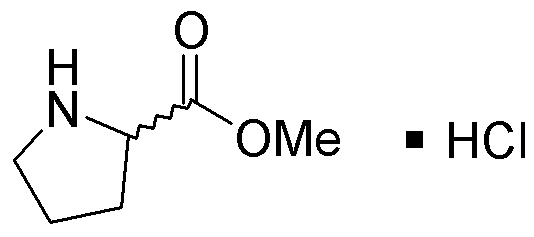DL-Proline methyl ester hydrochloride is widely utilized in research focused on:
- Synthesis of Pharmaceuticals: This compound serves as a key intermediate in the production of various pharmaceuticals, particularly those targeting neurological disorders, enhancing the efficiency of drug development.
- Peptide Synthesis: It is commonly used in the synthesis of peptides, where its unique structure aids in the formation of specific peptide bonds, making it invaluable in biochemistry and molecular biology research.
- Chiral Catalysis: The compound acts as a chiral catalyst in asymmetric synthesis, allowing researchers to produce enantiomerically pure compounds, which are crucial in the development of effective drugs.
- Food Industry Applications: It is utilized as a flavoring agent and in food preservation, providing an appealing taste profile while also extending shelf life, which is beneficial for food manufacturers.
- Cosmetic Formulations: This chemical is incorporated into cosmetic products for its moisturizing properties, enhancing skin hydration and improving product efficacy, making it popular among cosmetic formulators.
General Information
Properties
Safety and Regulations
Applications
DL-Proline methyl ester hydrochloride is widely utilized in research focused on:
- Synthesis of Pharmaceuticals: This compound serves as a key intermediate in the production of various pharmaceuticals, particularly those targeting neurological disorders, enhancing the efficiency of drug development.
- Peptide Synthesis: It is commonly used in the synthesis of peptides, where its unique structure aids in the formation of specific peptide bonds, making it invaluable in biochemistry and molecular biology research.
- Chiral Catalysis: The compound acts as a chiral catalyst in asymmetric synthesis, allowing researchers to produce enantiomerically pure compounds, which are crucial in the development of effective drugs.
- Food Industry Applications: It is utilized as a flavoring agent and in food preservation, providing an appealing taste profile while also extending shelf life, which is beneficial for food manufacturers.
- Cosmetic Formulations: This chemical is incorporated into cosmetic products for its moisturizing properties, enhancing skin hydration and improving product efficacy, making it popular among cosmetic formulators.
Documents
Safety Data Sheets (SDS)
The SDS provides comprehensive safety information on handling, storage, and disposal of the product.
Product Specification (PS)
The PS provides a comprehensive breakdown of the product’s properties, including chemical composition, physical state, purity, and storage requirements. It also details acceptable quality ranges and the product's intended applications.
Certificates of Analysis (COA)
Search for Certificates of Analysis (COA) by entering the products Lot Number. Lot and Batch Numbers can be found on a product’s label following the words ‘Lot’ or ‘Batch’.
*Catalog Number
*Lot Number
Certificates Of Origin (COO)
This COO confirms the country where the product was manufactured, and also details the materials and components used in it and whether it is derived from natural, synthetic, or other specific sources. This certificate may be required for customs, trade, and regulatory compliance.
*Catalog Number
*Lot Number
Safety Data Sheets (SDS)
The SDS provides comprehensive safety information on handling, storage, and disposal of the product.
DownloadProduct Specification (PS)
The PS provides a comprehensive breakdown of the product’s properties, including chemical composition, physical state, purity, and storage requirements. It also details acceptable quality ranges and the product's intended applications.
DownloadCertificates of Analysis (COA)
Search for Certificates of Analysis (COA) by entering the products Lot Number. Lot and Batch Numbers can be found on a product’s label following the words ‘Lot’ or ‘Batch’.
*Catalog Number
*Lot Number
Certificates Of Origin (COO)
This COO confirms the country where the product was manufactured, and also details the materials and components used in it and whether it is derived from natural, synthetic, or other specific sources. This certificate may be required for customs, trade, and regulatory compliance.


